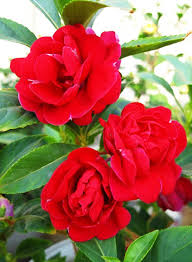Monsoon Growing Plant: Balsam
- Sachin Waykar

- Jul 11, 2020
- 4 min read
With their variety of colours like white, red, pink, and purple, these flowers attract attention of person immediately. This garden flower is famous flower of Victorian garden. This is none other than Balsam. Balsam is a quick growing flower. The plant is native to Asia, North America, & South Africa. In India, it occurs up to 1550 meters above the sea level. This plant occurs wildly in Deccan plateau, western ghats, and Konkan, etc.

They self-seed and are renowned for both ornamental and medicinal properties. These flowers are also called as Terada or Gaur flowers in Marathi and Gul Mehandi in Hindi. This flower is having its special importance in famous festival of Elephant headed God Lord Ganesha in India. During this festival on the third day, Goddess Gauri is worshipped. These flowers of Balsam are specially offered to goddess as part of pooja offerings. Leaves of this plant are also used in rituals of Ganesh Pooja.
Once flowers of balsam occur, they remain fresh for 4 to 5 days on the plant itself. After flowers, fruits of balsam emerge. If you touch these fruits, they crackle and hence this plant is also called as touch me not. Kids use these fruits to scare others.
Earlier times, balsams were used to grow only in monsoon or rainy seasons in India. However, now days hybrid species are also available in nurseries. However, original species which occur wild in India still have their own beauty. This plant grows upright upward in direction. Botanical name of this plant is Impatiens balsamina (Family – Balsaminaceae). The shrub of balsam are stright, 2 to 2.5 ft in height, with fleshy stem, with little bit hairy structures on the stem and have short branches.
Different varieties of balsam are cultivated in ornamental gardens. Balsam has alternate leaves on stem. Around 15 cm long pointed and speared shaped leaves are characteristic to balsam. Flowers come in crevices of stem or in bunches. In India around 150 species of balsam are available.
Balsam looks great when planted in containers, bedding and edging.
Planting
Balsam is grown directly from seeds. Seed packets of 100 seeds are available at just 30 INR. This plant is available in single and double petal forms. Seeds are sown in May or June and flowering gets started in July or August. Color of flowers stays for 3 days only. Best potting mix to grow balsam is mixture of garden soil, vermicompost, cow dung manure or home compost, and sand. Usually take pot of 5 to 6 inches diameter. Have a holes for water drainage. At bottom of pot, spread a layer of sand stones. Then add potting mix to container. Sow the seeds at 5 cm distance within each other. You can see small plants emerging from soil in next 5 to 8 days. Balsam prefers fertile, well-drained soil.It tolerates damp soil but not soggy and performs best in warm weather.

Sunlight
Balsam can usually grow in partial sunlight or full sun light. Minimum 1.5 to 2 hours of sunlight is required for this plant. Due to this, plants can easily show flowering even in rainy seasons. Huge bed of balsams can be easily seen on the plateau of Kaas (Dist. Satara, Maharashtra state of India).
Watering
Watering regularly is essential for this plant. However, well drained soil is required for plant. If water logging is there, then fungal attack is possible and roots of plant may die.
Fertilizers
Use water-soluble, quick release fertilizers such as NPK or diammonium phosphate (DAP) granules; or organic fertilizers such as bone meal etc. Onion peel, banana peel fertilizers are of great help for flowering this plant.
Pest attack and pesticide usage
Usually this plant is disease free. However, if Balsam is infested with disease such as Powdery Mildew, treat early with organic or insect repellents and fungicide.
Medicinal Properties of Balsam
Balsam has properties to reduce acidity and its flowers are cold by nature. In case of burns, applying paste of flowers is useful. It is good digestive, diuretic, and also useful in arthritis. 21% Edible oil can be extracted from seeds of balsam. In China, powder of seeds of balsam is used for easy delivery in pregnancy. It is also used for back ache in Philippines. In case of insect bite and snake bite, paste of leaves of balsam is thought to be useful. It also has expectorant properties and also used in treatment of cancer. Flowers of balsam also have antibacterial and antifungal properties.

Other uses
In Bali, leaves of balsam are used for eating. When flowers and leaves of balsam are crushed, they give color to nails. This is similar property like Henna.
Important tips
• Ample amount of water and well drained pot
• Wise and appropriate usage of Compost manure, vermicompost, and bone meal
• Sunlight of at least 2 hours
• Pruning plant using 2G method so that branching will be increased and hence flowering
So friends follow above tips to grow healthy balsams & enjoy colorful gorgeous blooms throughout year.
Happy Gardening !
Please don’t forget to like, comment, and share.










Comments